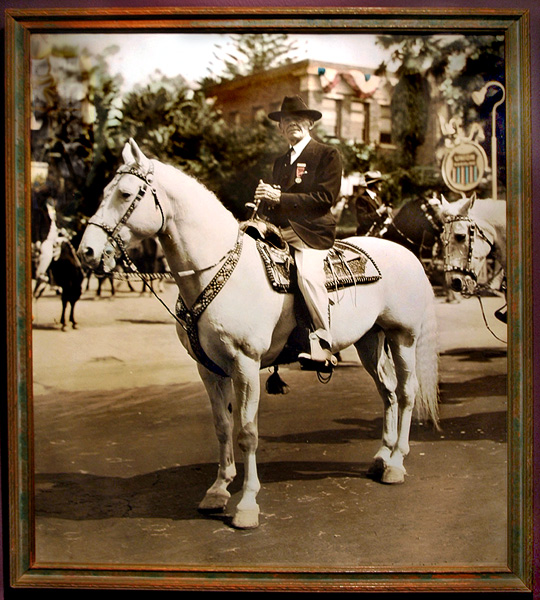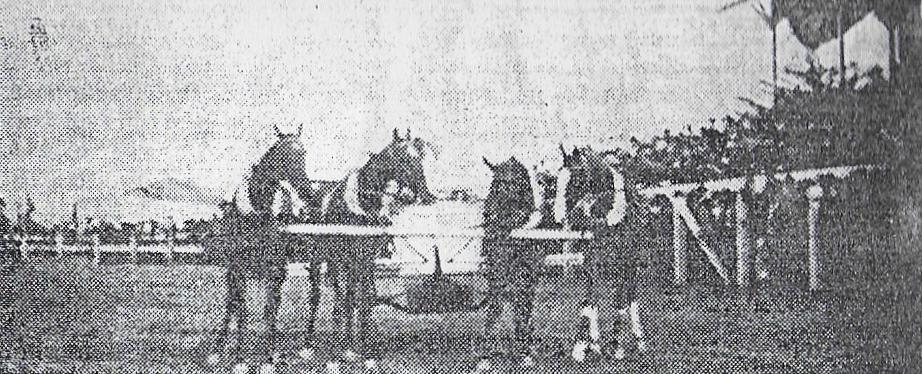The following article first appeared in the WEDNESDAY, JANUARY 9, 1985 edition of the “OJAI VALLEY NEWS” on Page A-1. It is reprinted here with their permission.
Supervisors forecast county problems as water, growth, health and homeless
by
Star Smith
As is the wont of many in the first day of each new year, county supervisors Tuesday looked back on the accomplishments of the past, then peered into their crystal balls, trying to foretell the issues of the future.
THE CONSENSUS: growth, water, health care, and the homeless will be the major issues for the county in the next year or two.
The occasion for the government soul-searching was the swearing in of reelected supervisors Maggie Erickson, representing Ojai Valley, Camarillo, and Santa Paula/Fillmore; John Flynn, Oxnard and Port Hueneme; and Susan Lacey, Ventura.
All three won decisively their reelection bids in June, Erickson taking 64 percent of the District 3 vote; Lacey, nearly 80 percent in District 1; and Flynn, running unopposed in District 5. Tuesday’s ceremony before a packed house in the Government Center boardroom was primarily an upbeat occasion.
Newly chosen chair of the board, Ed Jones of Thousand Oaks, reflected on the years since 1978, when he had last been chair. In that year, Proposition 13 was approved by California voters, and it threw local governments into a belt-tightening turmoil.
But, Jones said Tuesday, Ventura County adapted to the public mandate, and has come through the toughest times, emerging into “a period of cautious optimism, or prudence.”
IN THE SIX years since Prop. 13, inflation has totaled about 70 percent, Jones said, but Ventura County has kept a tight rein on spending. In 1978, the county spent $406 per county resident; this year, that figure is $407 per capita, a miniscule increase, Jones said.
The county has also been conservative in the growth of its staff; while the ranks of county employees have grown, the percentage of county employees to county residents is actually down, he said.
But, Jones warned, local voters evidently are not completely satisfied. While Proposition 36, billed as the measure which would close Prop. 13 loopholes, was defeated statewide in November, it passed in Ventura, a sign Jones said, that the county must continue to “put our own house in order.”
One of the housekeeping chores the board will face in the coming years is planning and controlling growth, predicted Supervisor Erickson. The county will continue to grow, she said, forcing local government into a delicate balancing act. One the one hand, “industry will be coming in, homes will need to be built” to support industry, she said.
On the other hand, the county must “look at the environment,” she continued. “We must balance (the two sides)…so our children and grandchildren can enjoy” the benefits of both.
“We are blessed with natural resources: a beautiful coastline…the Los Padres mountains…oil…agricultural lands…How we use that trust is an issue the board will continue to face.”
The future looks rosier than the past, but it has not been cleaned of stumbling blocks, warned Supervisor Flynn, who reeled off a long list of issues the county will confront.
WATER WILL continue to be a burning issue for the county and the rest of Southern California, he said, but the northern half of the state will not be willing to share in a solution to the problem until the southern half takes some responsibility for its water usage and management. For Ventura County, that means continuing an aggressive conservation program and abating seawater intrusion into the Oxnard Plain aquifer, Flynn said.
The plight of the homeless “is becoming increasingly acute,” Flynn said, and it will be a county responsibility to solve or at least ease the problem locally.
The health care philosophy of the county may have to be re-thought, he said, adding that the county should think seriously about continuing to provide health care for the poor, but “move away from competition with private hospitals” for patients with means to pay.
The county also will have to wrestle with waning authority amid growing responsibility, Flynn said, as state and federal governments mandate more local programs but don’t always give control to local governments. For example, he said, solid waste disposal is a county responsibility, but the cities have the power to override county decisions on the issue.
Mashburn leaving Youth Employment Service
This article first appeared in the Wednesday, June 7, 1989 edition of the “Ojai Valley News” on Page A-3. It is reprinted here with their permission. The author is unknown.
Mashburn leaving Youth Employment Service
Arlou Mashburn, co-director of the Ojai Valley Youth Employment Service, is leaving the agency because of funding problems.
The problem came to a head earlier this week when it was learned the service’s funding request to the United Way for $18,000 would not be honored.
Instead, United Way decided to give the agency $9,500, the same as last year.
The employment service’s board of directors on Monday voted to accept Mashburn’s resignation as a cost-cutting measure. The resignation follows recommendations made by United Way.
Mashburn said her resignation is effective June 16 unless an unexpected funding source is found.
Mashburn has been with the service since the 1970s and was a longtime director.
She said one of her biggest fears is that the Ojai Valley residents may not be aware of the importance of the program to the community.
Mashburn said that not only do many young people need the money they earn on jobs provided through the agency, they need the work ethic and self esteem jobs provide.
Mashburn said she has no immediate plans for the future.
Her husband retired two years ago, but she would like to continue some form of work on a part time basis.
“I don’t think I can do for myself without doing for others,” she said.
Tim Sidoti, the other co-director of Youth Employment Service, will remain on the job.
The service makes some 1,400 job placements a year for the youth of the Ojai Valley. There is no charge to employers or job seekers for the service.
Sidoti said United Way’s low grant was unexpected.
Sidoti, who was hired in January to increase funding and recruit more young people and businesses, said he felt that the employment service has made several changes to comply with previous requests made by United Way, including the generation of funds and solicitation of help from individuals and local service organizations.
“We didn’t really expect the whole $18,000, but I really expected more than last year. I expected $12,000, or at least $10,000.”
According to Sidoti, since he took over, the agency has added five new board members, who either belong to local service organizations or are prominent business people. It has received funds from the Optimists Club and the Rotary Club and it is currently negotiating for funds from the city as well as the Lions Club. It also sent out 1,600 appeals to various businesses and private employers requesting donations.
In addition, the employment service also increased the hours it is open and has conducted a training workshop for youth on how to find work.
At Monday’s emergency meeting, the service’s board had four options — to operate with a full-time director but with no other paid staff, to have a part-time director and part-time job placement clerk, to have a part-time director with a part-time job placement clerk as needed or to close the agency’s doors.
Prior to the meeting, Sidoti had said any of the first three options would diminish the quality of service.
“Being the size of agency that we are, you have to have the personnel to put out a quality product,” he said. “I hate to use that term product, but when you are giving out that kind of expertise, it takes time and money. You just can’t do it half way. I just don’t feel it can be done half way.”
Women-of-the-Year give time, energy to help community
The following article was first printed in the WEDNESDAY, JANUARY 9, 1985 edition of the “OJAI VALLEY NEWS” on Page A-1. It is reprinted here with their permission.
Women-of-the-Year give time, energy to help community
by
Brenda Loree
When the OVN news staff chose Arlou Mashburn and Carmen Robertson as its 1985 Women-of-the-year, it was without the knowledge that the two of them not only knew each other, but have been great friends for 24 years, and that, their lives have dovetailed and coincided many, many times since they met in 1961.
“When I moved to Ojai in 1961, Arlou lived across the street,” said Robertson. “The day after we moved in, the doorbell rang and there was this beautiful glossy head of hair with a coffeepot. It was her. It was my welcome to Ojai.”
AND WHEN THEY showed up for a picture-taking session together on Monday, throwing their arms over each other’s shoulders, assuming a buck and wing position and announcing themselves as “The Pit Sisters,” we weren’t sure but what they had misunderstood and thought they’d won the Ted Mack Amateur Hour.
Such high spirits are but symptomatic of high energy these two human dynamos possess. Rare is the person in Ojai Valley who hasn’t been cheered by, but more to the point, helped by, one or both of these women.
Neither stands on much ceremony. Neither holds formal office nor chairs important commissions. What they both have is heart, “miles and miles and miles of heart. “They are both such lobbyists for the Ojai Valley and its people that if they took their act to Washington, D.C., they’d be banned for undue influence.
Officially, Mashburn is the executive director of the Ojai Valley’s Youth Employment Service (YES). Officially, Robertson is the Ojai Valley representative of the Ventura County Arts Advisory Council.
IT’S WHAT THEY DO unofficially that singles them out. The two of them combined have probably driven their and everyone else’s kids in Ojai Valley enough miles on field trips to go around the world twice. They’ve both been unofficial sympathetic ears to enough teenagers (and their parents) in the valley to qualify for master’s degrees in family counseling.
Mashburn
One of Mashburn’s bosses, Ginny Barrett, member of the YES board of directors, said it best about Arlou: “She’s done so much more than what she’s paid to do, put in so many more hours, that she’s still our best volunteer.”
“When you see Arlou coming, you know you’re going to have a good time,” said the Ojai Valley native, can’t remember a time when she wasn’t working with youngsters on a volunteer basis. “Arlou and I were PTA nursery school volunteers, elementary school on up.”
Being mother of six and working almost exclusively with children on her job only makes her want to do more with youngsters.
“There aren’t enough people who like kids,” she said as she sat in her cubbyhole YES office on the grounds of Chaparral High School. “Hiam Ginott, my idol said you should give your child a way out. Don’t come down on them all the time. We’d never talk to adults the way we talk to our kids.
“I wish there was an outreach program here for the kids, something like Interface,” she mused between calls; calls from people wanting to hire someone and calls from kids wanting to be hired.
AFTER AN hour and a half of trying to squeeze an interview in between calls and visits from youngsters, it became obvious that Mashburn is her own “outreach program.” She serves as a personal counselor as much as a placement director on the job. Her manner is so disarming, so non-threatening, that monosyllabic teenagers walk in and find themselves pouring their hearts out to her.
“See how I love this job,” she beamed after effecting a particularly difficult job placement by phone, one in which everyone was happy. “Isn’t this great?”
“What I most hope to do here is maintain the reputation of Evy Foyil. She was here before me and it’s easy for me because of her example,” she said.
Mashburn will also be honored later this year when she leads the annual Independence Day parade down Ojai Avenue on the 4th of July as its Grand Marshall. Barely five feet tall, Mashburn will probably have to sit in a booster chair so her fans can see her in the back seat of the convertible. She won’t mind, because from her standpoint, it will mean she’ll have a better view of all of her friends.
Robertson
“She works for the good of the artists in this community,” said Carmen Robertson’s longtime friend Diane Volz. “She serves them; she brings the public to them. That’s her joy.”
ANYONE acquainted with Robertson has been buttonholed at one time or another to at- [missing words] there. She worked with the Presbyterian Church youth group and others.
In recent years she has worked as an aide at all levels of the Ojai school system, particularly with the special ed children. “I’m best as helping kids feel good about themselves,” she says. “If you say anything, say I stand for the dignity of children.”
Asked about her supreme accomplishment she said, “I was cleanup hitter for the Topa Topa Elementary School baseball team.”
ROBERTSON HAS very nearly lead two lives in one. Born and raised in Los Angeles, she became a child actress literally at the age of six months. For the next 26 years she worked for the likes of W.C. Fields, Bonita Granville, Jane Withers and appeared in “Our Gang” comedies. As she grew up she worked with Clark Gable, was a stand-in for Lana Turner and swam for two years in Esther Williams movies. “I spent two years under water. I also dived for Ginger Rogers. I was a good swimmer.”
Once she and her friend Diane Volz worked in the movie “Ziegfield Follies” together; they only realized it years later when they met in Ojai. Robertson was in the water and Volz was on the stage in a lavish “smoke-flame water ballet number.”
Then Robertson met and married yacht skipper Jack Robertson; they started a family and moved to Ventura County. The family grew to include Nick, Drew, Cullen, Winslow and Sydney, now all grown and all distinguished scholars in one way or another.
The day she started her family, she retired from the movie industry; the nurturing of her (and other people’s) children became her career. She and Jack resisted temptations to leave because “we wanted our family to have the Ojai way of life.”
“I came home when I came to Ojai. This is a mystical valley. I have a mystical streak and I feel better here than anyplace else.”
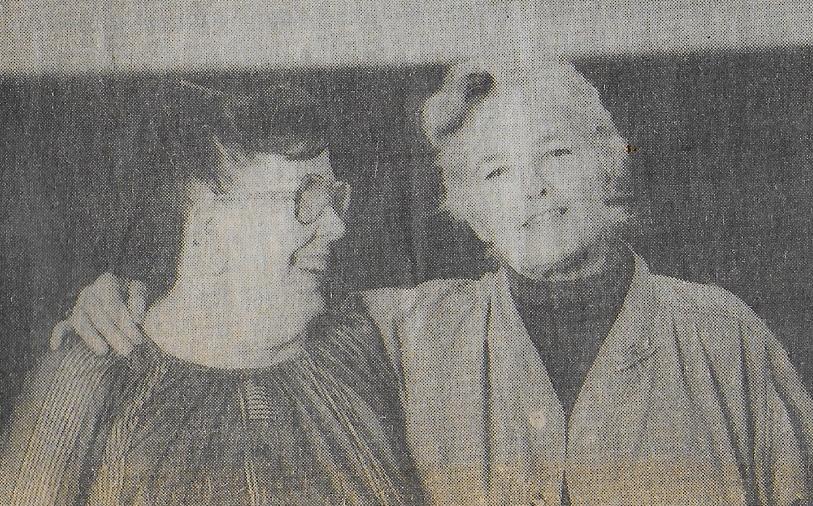
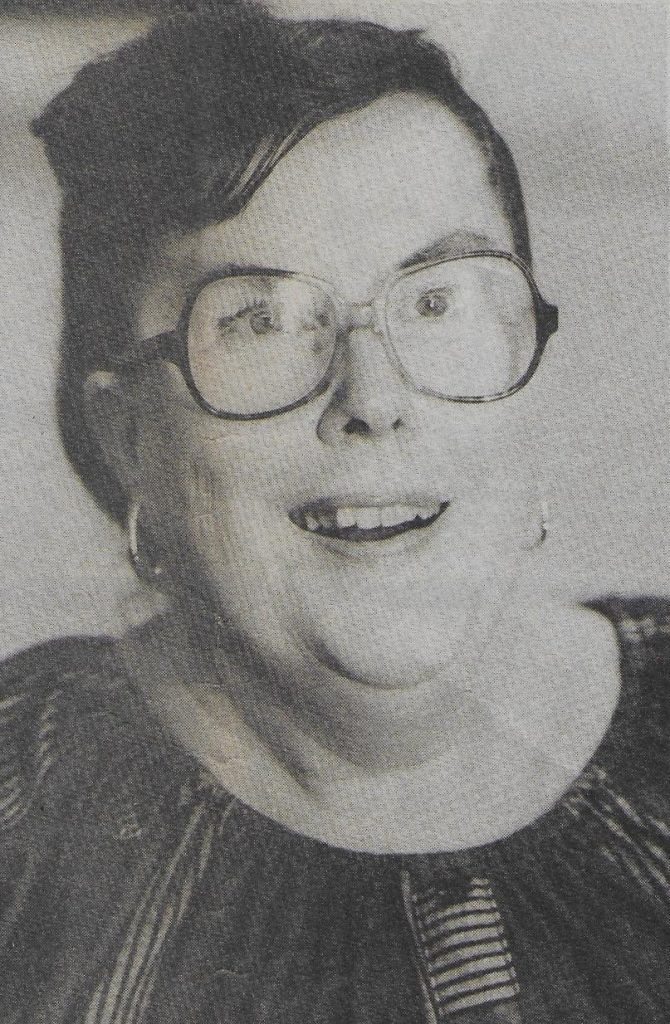
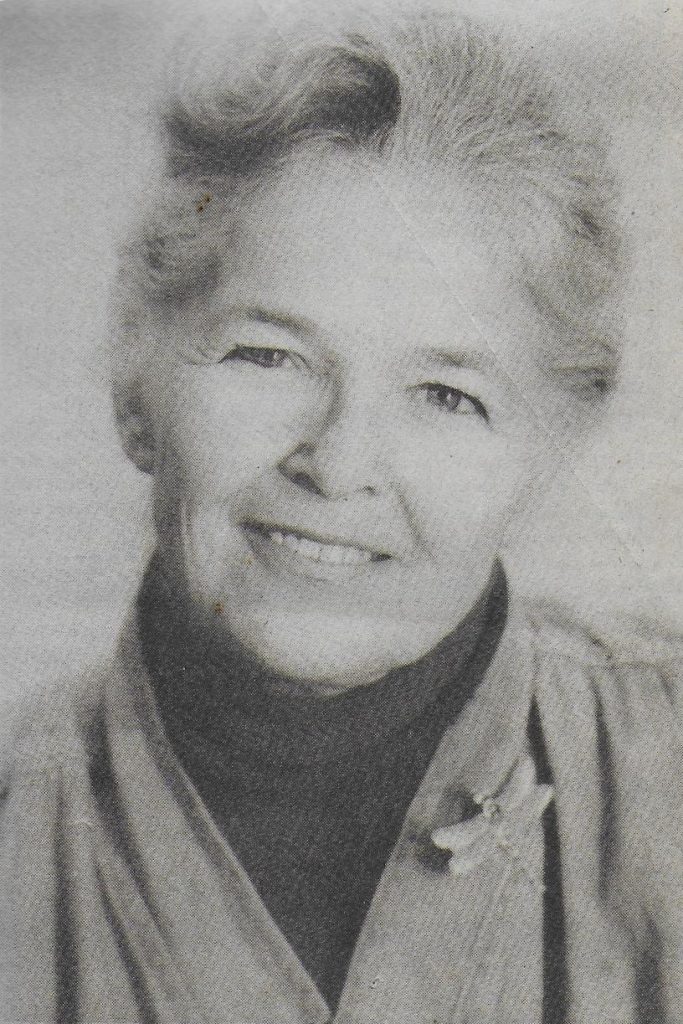
Hard work and no pay reward a vital job
The following article was first printed in the Wednesday, July 28, 1993 edition of the “Ojai Valley News” on Page A-1.
Hard work and no pay reward a vital job
By
Mike Palmer
Needed are a few good men, any age, any occupation (even attorneys or bankers), on-call 24 hours a day, must provide their own equipment and be willing to work for no pay at all hours of the day or night.
Add to these requirements months of training, an extensive background check, the need for a unanimous vote of 20 other team members to join and you have the requirements for membership in one of Ojai’s most select groups — The Upper Ojai Team of Ventura County Search and Rescue.
According to team member Tom Farmer, “You have to be 100 percent committed. You have to be ready to instantly drop what you are doing and go out on a rescue. It takes strong family support.”
He said the hours required of team members may vary from just a few to over 100 per month depending on need.
Farmer went on eight rescues during five months and participated in many training exercises before he was voted team membership, he said.
Any team member has a veto power regarding new members as does the Ventura County Sheriff’s Department.
The Upper Ojai Team is composed of different occupations. Some of these include a banker (Farmer), an attorney, a medical technician, a landscaper, several ranchers, an insurance broker and numerous others. Ages vary from 20 to 70 in the Upper Ojai Team.
Although the team is currently all male, it has had female members. All are welcome that can meet the rigorous physical requirements for membership, according to Farmer.
The team’s last rescue involved an 18-year-old woman, lost while hiking in Santa Paula Canyon. The search started at 9 p.m. and she was found at 2 a.m. the next day, he said.
Lost hikers, plane crashes and missing children are the most common call-outs, according to Farmer.
Although each of the three Ventura County Search and Rescue mountain teams are somewhat autonomous, they are under the over-all direction of the sheriff’s Lt. Arv Wells in Camarillo.
All calls for search and rescue in the back country go to Wells or his assistant, and they make the decision whether to call out one of the teams.
All team members carry beepers and equipment 24 hours a day, seven days a week, Farmer said.
Wells said, “Most calls come from various watch commanders around the county.
“Our decision to respond when a person is two hours overdue, depends on many factors. The age, back country experience and weather will control if an immediate response is indicated.
“If there is any doubt, we would rather respond and cancel a search after someone shows-up, rather than wait.”
Wells supervises eight search and rescue teams and three helicopter units county-wide.
In addition to three mountain teams, there is a search dog team, an underwater team, a medical team, a mounted posse and an administrative support team.
He said the 180 volunteers who comprise the eight teams save the county $500,000 annually. Wells said most team members provide all their own equipment and devote hundreds of hours to training and rescues, all for the “self-satisfaction of helping others in adverse conditions and some times saving lives.”
Farmer said he got involved after he witnessed first-hand the many hours devoted by the team when his son, Troy, was lost in the back country last December.
Although, Troy subsequently came out without help, Farmer said, “I learned to appreciate what a victim’s family goes through. That is when I decided that I wanted to help.”
Farmer said the Upper Ojai Team is selling t-shirts to help finance the purchase of some new equipment. Shirts may be purchased for $12 at the Ojai Valley Bank, 1207 Maricopa Highway, Ojai.

Troop 504 celebrated BSA birthday with Court of Honor
This article first appeared in the Wednesday, March 10, 1999 edition of the “Ojai Valley News” on Page A-6. It is reprinted here with their permission.
Troop 504 celebrated BSA birthday with Court of Honor
by
Andy Bisaccia
OVN contributor
A Court of Honor and Parents’ Night was held recently by Troop 504 to celebrate the 89th birthday of the Boy Scouts of America (BSA) and the 92nd birthday of the world scouting movement.
The event was held in conjunction with Boy Scout Week.
The newest scout in the troop, Brian VanAken, started the ceremony by lighting 12 candles on a long candelabra while repeating the 12 points of the Scout Law.
Scoutmaster Andy Bisaccia conducted an investiture awarding the Tenderfoot Scout badge to B.J. McLeod and John Obraza. The Second Class Scout rank ceremony was convened by Tom Swetek, assistant scoutmaster, who awarded the Second Class badge to Kevin McLeod, B.J. McLeod and John Obraza.
The First Class Scout rank ceremony was convened by Lee Rosenboom, assistant scoutmaster, who awarded the First Class badge to B.J. McLeod. Bisaccia awarded two merit badges to Kevin Marshall that are required for the Eagle Scout award: Citizenship in the Community and Personal Management.
After each ceremony, miniature badges were pinned on the mothers in appreciation for the role they play in helping their sons in their scouting endeavors.
The highlight of the Court of Honor was the Star Scout rank ceremony, convened by Rick Bisaccia, assistant scoutmaster, who awarded the Star Scout badge to Kevin Marshall, which now places him on the pathway to the Eagle Scout award.
Marshall’s father pinned the badge on and Kevin awarded the miniature to his mother who wears them all on a necklace.
Then, Scoutmaster Bisaccia made the following troop and patrol promotions: B.J. McLeod, senior patrol leader; Kevin McLeod, patrol leader of the Panther Patrol; John McLeod, assistant patrol leader; Matt Harder, patrol leader of the Eagle Patrol; John Obraza, assistant patrol leader; Nathaniel Harnett, scribe; and Chad Butler, quartermaster.
One-year attendance awards were given to B.J. McLeod, Kevin Marshall, Kevin McLeod, John McLeod and Matt Harder.
The evening ended with a talk on the history and background of the scouting movement by the scoutmaster. One of the three known complete collections of the scout handbooks was put on display, including the first handbook, which came out in England in 1908.
Troop 504 is sponsored by the Ojai Rotary Club in partnership with the Ojai Unified Methodist Church and meets every Monday from 7 to 9 p.m. at the church hall. Boys between the ages of 11 to 17 are invited to join. Call 646-9877.
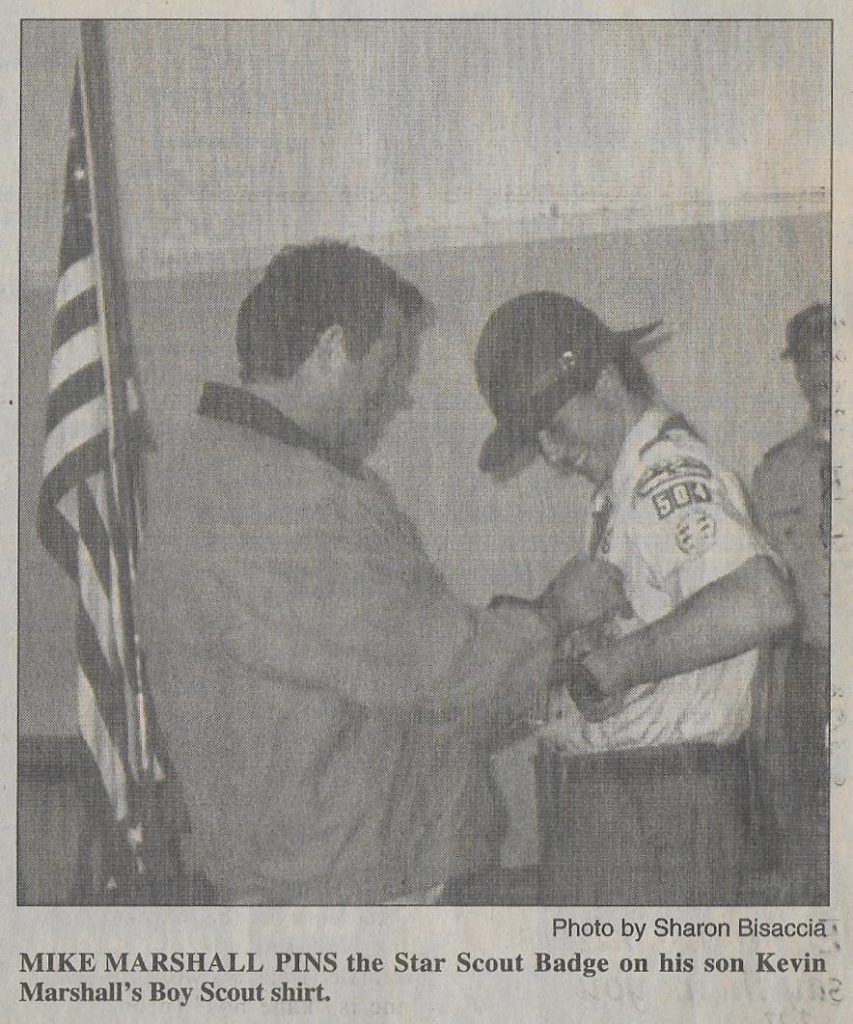
Tourists big depositors in city’s bank account
This article first appeared in the Monday, June 5, 1989 edition of the “Ojai Valley News” on Page A-1. It is reprinted here with their permission. The author is unknown.
Tourists big depositors in city’s bank account
Like it or not, Ojai is a tourist town and the city is becoming more and more dependent on the taxes visitors pay.
City Manager Andy Belknap, who has prepared the tentative budget for 1989-90, said three revenue sources — property tax, sales tax and bed tax — account for 64.4 percent, or nearly two thirds, of the city’s $2,852,000 general fund.
The bed tax is tied directly to tourism and the sales tax is indirectly related.
The bed tax has become increasingly important in the past 10 years, Belknap noted.
In the 1979-80 budget, he said, it accounted for 7.5 percent of general fund revenues, but in the new fiscal year it will amount to 17.2 percent, an increase of 229 percent in a decade.
The bed tax was increased by a third in 1985 and this accounts for some of the increase, but Belknap said the figures still show more and more tourists are coming to Ojai and leaving their tax dollars behind — an anticipated $490,000 in the new fiscal year.
Sales tax figures also point to the impact of tourism on Ojai. About 25 percent of the general fund comes from the sales tax, a figure that has remained relatively constant over the years, but per capita comparisons tell a different story.
Ojai had the third highest sales tax per capita in Ventura County for the fourth quarter of 1988, according to the State Board of Equalization. Belknap noted the per capita figure for Ojai of $2,017 was exceeded only by the cities of Ventura and Thousand Oaks, both of which have regional shopping centers.
These retail centers account for much of those communities’ sales tax revenues, Belknap said, noting that Ojai lacks such a center.
And, Ojai’s annual growth rate of .64 of a percent makes it the slowest growing community in Ventura County. This, said Belknap, means that a populations shift is not accounting for the sales tax locally.
The manager said all this is a mixed blessing for Ojai. While it brings money into city coffers, it also makes the city vulnerable to economic shifts.
The tourist-based economy puts a strain on several city services. Traffic is the most obvious, according to the manager, but there are others as well.
Belknap said he would like to see Ojai approach the situation by building a large budget reserve for bad times and to diversify the local economy.
Belknap used the Oxnard city budget by way of comparison.
Oxnard’s reserves equal about 15 percent of its annual budget, while Belknap is trying to build a 30 percent reserve locally.
In terms of revenue sources, the manager noted that property, sales and bed taxes account for less than 40 percent of Oxnard’s general fund compared to roughly two-thirds in Ojai.
Belknap cited Houston as an example of a city that relied on a single-based economy. When the bottom fell out of the oil market, Houston’s economy collapsed.
The answer for Ojai is to be conservative, Belknap said, adding the city must expand it economic base and increase its reserve for bad times.
Memories of times before freeways recall life as simple, safe
The following article first appeared in the Wednesday, May 17, 1995 edition of the “Ojai Valley News” on Page A-8. It is reprinted here with their permission. The author, Lee Strohbehn, was a longtime dentist with a practice in the Ojai Valley. The photo of Dr. Storhbehn was added by the “Ojai Valley Museum”.
The Golden Years
Memories of times before freeways recall life as simple, safe
by
Lee Strohbehn
Before freeways, was it only the exuberance and vitality of spirit of young parents that drew us to downtown L.A.?
Some of the fondest memories I have are those when my wife and I took our family to the Dorothy Chandler Pavilion. How well I remember Richard Kiley and the Man of La Mancha at the Mark Taper Forum and Ingrid Bergman at the Amanson Theatre.
And the concerts — we were there to see Zubin Meta conduct and to hear the L.A. Phiharmonic. And afterward to take the family to dinner right there at the Music Center, or to a favorite, Edwards Steak House on Alvarado St.
Let’s do lunch
And then there were trips to the Hollywood Bowl. What a delight, to take a lunch and sit high up under the stars to listen to programs which, as a farm-bred Iowa boy, I never thought I or my family could be part.
As parents, we had a feeling of fulfillment to realize that our three children enjoyed these experiences as much as we did and that we could provide them.
Life was affordable
Admission prices at that time seemed affordable. Nor did I have the feeling the environment was unsafe, or that the drive home late at night was an ordeal.
How times change! How could I afford those adventures now for five people?
And if Edwards Steak House were still there, I wouldn’t dare take my family to a restaurant on Alvarado. Somehow to drive the freeways, especially at night, is daunting to me now.
As our family grew older and we began to rely more on local entertainment events, Frank Salazar came along and the Ventura County Symphony orchestra was born. We subscribed immediately as charter members.
How delightful it was to recognize Ojai’s Frank Roller and his violin, Dorothea Walker and her cello, and Lavonne Theriault and her drums down there among all the other Ventura County musicians. We truly felt linked to beautiful programs.
I’m one of those untalented people who knows nothing about music but enjoys it endlessly. There are times when I lose myself, when I’m oblivious to everything around me and I feel one with a composer who has struck the chords I like. I cherish those moments.
Oldies missed
I confess that I was confused when Maestro Salazar left the orchestra. I had, in a sense, matured with him musically and I must say I miss him. I understand there has been a parallel experience for those audiences who have been attending performances of the Conejo Valley Symphony Orchestra.
Now those two orchestras are undergoing further transition. The apparent objective of those behind the podiums is to produce a “World Class” orchestra by combining talent and weeding out those who do not perform to and exclusive standard. I have heard that they hope to attract excellence from outside the area.
My limited knowledge of music doesn’t allow me to discriminate the finer levels of quality. I always enjoyed Frank Roller’s violin but I seriously doubt that his talent would have allowed him to survive the judgments that must be made to seat one orchestra instead of two in Ventura County.
I love Ojai’s summer band concerts on Wednesday nights in Libbey Park. I like the sound and revel in the incomparable social ambiance.
Memories linger
I used to feel something akin to that when the Ventura County Symphony was young, especially when I could bond with Roller’s violin. Although Frank isn’t with us now, his memory still lingers and epitomizes a homegrown spirit I miss in the Orchestra.
“World Class,” if it means change in community participation, simply doesn’t mean that much to me. I’m sorry to see the Ventura County Symphony Orchestra elevated to a class conscious status beyond my ability to enjoy or afford.
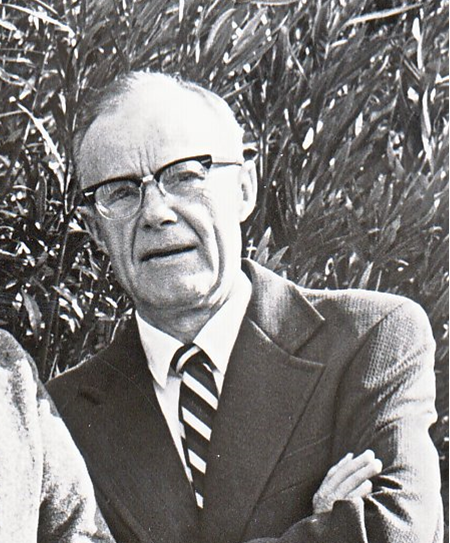
Artists in Paradise

Permanent Collection, Ojai Valley Museum
This essay by Anca Colbert originally appeared in “Ojai Studio Artists – 3 Decades” a book published in 2013. Colbert is an art adviser, curator, writer, and long-time resident of Ojai. It is published here with Colbert’s permission. ©2013 Anca Colbert – All Rights Reserved.
This book offers a glimpse into the lives of 60 artists who live and work in Ojai, a small town, more of a village really, nestled in a fertile mountain valley surrounded by nature of breathtaking beauty and bathed in legendary light. Together as members of the Ojai Studio Artists, yet always alone as individuals, they weave stories reflecting their life and their vision in this magical place.
Consider the spectrum of artists in this group. Stylistically, they represent a vast range of visual arts creativity, from figuration and hyperrealism to expressionism and abstraction, from traditional to experimental, from plein-air to political. They use most media: painting in oil, acrylic, encaustic or pastel; drawing with pen and ink; printmaking; photography; collage; assemblage; making sculptures, ceramics, pottery.
If one of art’s highest purposes is to ask questions of those making it and of those experiencing it, it seems relevant to ask questions about the OSA group: why does it exist? And why here?
Geography and nature have much to do with the group’s existence. Ojai, an old Chumash Indian outpost, was always a land cultivated for its agricultural abundance. In the late 19th century it was embraced by many newcomers for its beneficial climate. During the 20th century it became a magnet for educators, writers, artists, celebrities, creatives in all fields, and seekers of life’s meaning and higher purpose.
By now Ojai is renowned as a fertile paradise for its orchards and its artists.
My first visit to Ojai was an invitation to lunch at Beatrice Wood’s. It was the early 1970s. I had just moved from Paris to Los Angeles, and Beatrice had just moved to her new house and studio in the Upper Valley, facing the Topa Topas. I was mesmerized by Beatrice’s iridescent luster glazes and whimsical sculptures, and charmed by her conversation and personality. On that very first trip I fell under the spell of the Ojai Valley.
Why have so many visual artists chosen to settle here? Ojai is a place unlike most others. Those drawn to this valley have a strong sense of belonging here, of living in an earthly haven. A few other art communities are famous for their singular settings. Taos comes to mind. The Hudson Valley. St. Paul de Vence. Similarities abound: natural beauty, spiritual energy, space, silence, light quality, a protected environment, a gentler life than in the cities, yet a convenient proximity to important art centers.
Artists use their imagination to create worlds: theirs, and ours. The process is fraught with uncertainty and doubts about the purpose of their life work, about exposing it and exhibiting it, about financial survival, about recognition. That takes courage. A support system is essential. Ojai offers a nurturing environment for all creatives, but members of OSA choose to participate in a somewhat structured community of kindred souls. Their homes and studios are within minutes from each other. So they meet, they party, they talk, they bond.
For “Reflections,” an OSA group exhibition organized by the Ojai Valley Museum in 2013, the museum asked participating artists to ponder what it meant for them to belong to the group. The painter Elisse Pogofsky-Harris wrote on that occasion: “Art making for me is a solitary undertaking, which being an only child, suits me well. But as I journey down the path my paintings require I follow, I am grateful that there is an OSA to provide the possibility of having colleagues, peers and even friends with whom to share moments of joy as well as times when the muse is hiding.”
Being an artist carries the central contradiction of a self-enclosed, isolated life trying to connect with others in the world. Not an easy balancing act. As Georgia O’Keeffe famously wrote: “I found I could say things with color and shapes that I couldn’t say any other way – things I had no words for.” Artists tend to favor solitary lives, and usually do not like to talk about their work. Yet here they come together once a year in October for the OSA Tour.
The tour has drawn thousands to Ojai over the years. Most art lovers cherish the opportunity of being welcomed into the artists’ studios, to connect with them in an intimate manner: It’s a highly charged personal experience, one of immersion into that individual life, work and environment. The power of images in an intimate setting has a singular quality far different from their effect in public museum spaces, or in the often desensualized world of big city galleries, or in the all-encompassing, fast-paced, consumer-oriented international art fairs, which in recent years have changed the nature, geography and economics of the art world.
Picasso’s comment about art being “just another way of keeping a diary” rings true as one looks at the stories told by this group of OSA artists. As painters, sculptors, photographers, et al., they leave a palpable trace of what they see and what they feel. Yes, artists do tell stories: about fruits and vegetables; mountains and skies; their loved ones, dreams and visions. The thread of a singular life’s story interwoven with others creates the fabric of their connection. It keeps changing slowly under our eyes, just as do the shifting rays of light in this valley.
Intangible Spirit of The Ojai (No. 1)
The following article first appeared on June 6, 1961 in a newspaper that became the “Ojai Valley News”. The article is reprinted here with the permission of the “Ojai Valley News”. The author is Ed Wenig. Wenig wrote a series titled “Intangible Spirit of The Ojai”. He did not title each of his articles. Therefore, the “Ojai Valley Museum” has added “(No. 1)” to the title to distinguish it here from other articles with the same name.
Intangible Spirit of The Ojai (No. 1)
by
Ed Wenig
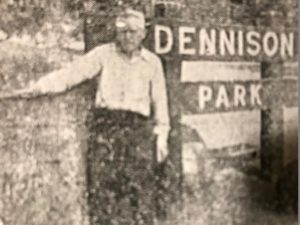
Beautiful, oak-covered Dennison Park is known throughout the Ojai Valley as a “family” park –– a place where people can come for quiet and rest. Earl Lively, park caretaker, points out that while other parks, by demand, have concessions in food and drinks and facilities for games and entertainment, there is only great natural beauty to lure the visitor to Dennison Park.
From the several lookouts on the 33 acre expanse at the top of the Dennison grade, one sees two entire Ojai Valleys — Lower and the Upper — simply by turning around. It is no wonder that in 1924, when the Dennison family deeded the property to the county the local paper stated, “A more beautiful and charming park site could not be found in the county.”
There is some significance to the picture above showing Mr. Lively pointing to a spot on the huge rock at the park entrance. For he, along with members or the Dennison family and other pioneers have often wondered why the plaque that was promised by the supervisors of 1924 was never made, or, if made, was never fastened to the rock 37 years ago.
In 1924, the year the county supervisors accepted the property as a park, and Tom McGuire of the Upper Ojai was ordered by the Board to bring this 40-ton rock from the east to the west side of the new grade road, as a unique and permanent entrance marker. “This I did,” said McGuire recently, “and what a job it was for my cat of that year! I understood that a special bronze plate was to be securely fastened to the rock explaining, and commemorating the generous gift of the Dennison family. Why it was never completed I, nor anyone else, has ever found out.”
According to Mr. Lively, the park site seems to have been a favorite camping place and home for at least three different and unrelated Indian cultures. While historians may write their speculations of the long, unrecorded past, Mr. Lively takes pleasure in showing visitors the mortars on a huge rock made undoubtedly by the Oak Grove Indians, the first Indian culture of 10,000 or more years ago. Then he describes the second culture, the so-called Hunter Indians, who, with bow and arrow and stone ax were able to hunt large animals for food, clothing and housing.
But when caretaker Lively talks about the third Indian culture, the Canalinos or Chumash, a note of sadness creeps into his voice. “With the coming of the white man, with his impatience, his faster way of living, and his disregard of nature’s balance, the Chumash disappeared. But, with real enthusiasm, Lively concluded: “I Like Dennison Park. It’s still a little world all of its own, high up here between two lovely valleys, just as it was for the Oak Grove, the Hunters, and the Chumash. When I occasionally find artifacts of one or the other of the three cultures, I go back in my imagination to the days of long ago when this little mountain top was a real paradise for the Indians.”
Chariot races were exciting events
The following article first appeared in the “Ojai Valley News”. The exact date is unknown, but its author, Ed Wenig, wrote a regular history column for that newspaper in the 1970’s. The article is reprinted here with the permission of the “Ojai Valley News”.
Chariot races were exciting events
by
Ed Wenig
“One of the outstanding incidents of the (Ventura County) fair was the winning of the chariot race by Tom Clark of Ojai in the world’s record time of 52 seconds. Tom claims that, knowing he had the race well in hand, he held his horses up. If he had chosen to let them go his time would have been somewhere around 51 seconds.”
This was the exultant report in THE OJAI on September 24, 1926. The colorful county supervisor for the Ojai district had once again distinguished himself in the field of horsemanship. This time his achievement was significant enough to warrant a special article in the Boston Globe, which told of the new world record.
In those days chariot races were truly exciting events. The drivers were garbed in ancient Roman costumes, and the chariots, patterned after the ones used in the Colosseum of Rome, rattled magnificently by on their wooden wheels.
Stage Coach Driver
Tom Clark, whether dressed in a Roman toga or in conventional modern attire, was always a colorful personality. As a teenager he had become a driver of stage coaches between Ventura, Ojai, and Santa Barbara. To the fashionable winter patrons of the Foothills Hotel the ride in his stagecoach from railroad station of Santa Barbara or Ventura was a much-anticipated event.
Many were the holiday expeditions piloted by Tom Clark. No matter how tortuous the road or how many streams there were to be forded, no one ever had the slightest doubt that Tom Clark would be in complete control of his horses and stagecoach. His livery stable at the corner of Signal Street and Ojai Avenue was the starting point of many trips both by stagecoach and horseback throughout Southern California.
His daughter, Elizabeth, now living in Santa Ana, recalls the joyous expedition of her Nordhoff High School graduating class to Wheeler’s Hot Springs. Two tallyhos were employed, one driven by her father, and one by her uncle, William Clark. The road was so winding that often the lead horses could not be seen by the passengers as they turned the corners. She recalls that at a moment of great excitement came when a Stanley Steamer approached on a blind curve, and it required all the skill of the drivers to keep their horses from bolting at the encounter.
